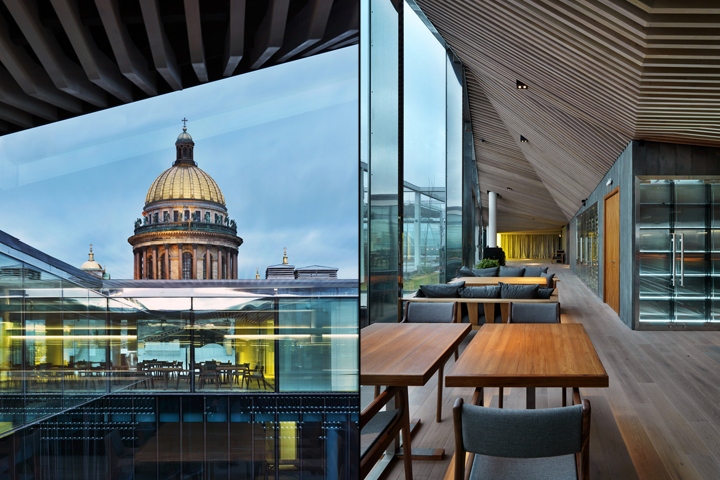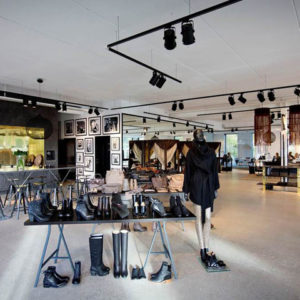


Everything is built like a maze of canals, bridges, domes, and towers decorated in a variety of colors, artfully designed gardens, squares, and monuments. We’re not in Venice, nor in Amsterdam, but in chameleon-like St. Petersburg, which changed its name three times in less than a century – from St. Petersburg to Petrograd to Leningrad – only to go back to its historic name after the fall of the Berlin Wall. The so-called “Russian gastronomic revolution” took root in the heart of the Soviet “Second Capital,” with innovative chefs and unconventional locales running parallel to institutional propositions and providing a dynamic alternative where design is a fundamental element.

Located on the top floor of the Gazprom Headquarters, the Mansarda restaurant is a symbol of change, with its more than 1000 square meters of open space facing St. Isaac’s Cathedral and enhanced by a large scenic terrace overlooking the historic city center. The restaurant, like the colossal natural gas company’s entire office complex, was designed by Piuarch as an interpretation of St. Petersburg’s distinctive traits: colors and reflections that recall its history are nonetheless associated with contemporary materials and forms, creating an architecture with a strong identity.

It is the unusual treatment of the surfaces of both the facades and the restaurant’s interior that define the stylistic dimension of the design: the furnishings are essential and leave room for the ceiling, floor and walls, the real protagonists of this space, together with the view of the city and its monuments. The ceiling has planes with different slopes and a three-dimensional geometric design, emphasized by the use of gray oak strips spaced at a distance of 10 cm, which gives the impression of a constantly moving surface. The floor, also in grey oak, instead uses floorboards set in a perpendicular direction to the ceiling, creating a pleasant contrasting effect. The outer walls alternate glass surfaces with vertical rectangular panels at different angles, shattering the reflections of light.

Enclosed within these vibrant surfaces, the furnishings are absolutely minimal: the dining room has square tables with walnut tops arranged in a regular layout and matched with wooden upholstered chairs, while various decorative screens made with a lacquered black frame and a cascade of hanging spoons create unusual decorative partitions. A bar at the center of the restaurant is a more informal area for sipping a cocktail or a glass of wine while admiring the dome of St. Isaac’s Cathedral. Spacious, contemporary, and above all balanced, the Mansarda embraces the history of the Soviet city while celebrating the impetus for renewal and change, overturning traditional canons.
Design: Piuarch
Photography: Andrea Martiradonna




https://www.archdaily.com/882661/mansarda-restaurant-piuarch







Add to collection










